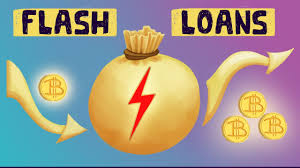A flash loan is a unique type of loan in decentralized finance (DeFi) that allows users to borrow funds without providing any collateral.
The key requirement is that the borrowed amount, along with a small fee, must be repaid within the same blockchain transaction.
If the loan is not repaid in time, the entire transaction is reversed, ensuring that no funds are lost from the lending pool.
Flash loans are powered by smart contracts, making them a distinctive and powerful financial tool in the DeFi space.
How Flash Loans Work
Traditional loans require borrowers to provide collateral, which serves as security for the lender in case the borrower fails to repay. However, flash loans operate differently. They do not require collateral because they must be repaid instantly within a single transaction. If the borrower does not return the funds in the same transaction, the blockchain automatically cancels the entire process, ensuring that no assets leave the lending pool permanently.
Since flash loans exist only for a brief moment—within the time it takes for a single blockchain transaction to be processed—they give users temporary access to large amounts of funds. This opens up opportunities for arbitrage trading, liquidation of debt positions, collateral swapping, and other financial strategies.
What Are Flash Loans Used For?
Flash loans have several practical applications in DeFi, including:
- Arbitrage Trading: Traders use flash loans to take advantage of price differences between different cryptocurrency exchanges. If the price of an asset varies across two exchanges, a trader can use a flash loan to buy the asset at a lower price and sell it at a higher price, making a quick profit before repaying the loan.
- Liquidations: In DeFi lending platforms, borrowers must maintain a certain level of collateral. If their collateral value drops below the required level, third-party liquidators can use flash loans to pay off the borrower’s debt and collect liquidation rewards.
- Collateral Swaps: Flash loans allow borrowers to swap the collateral backing their loans without needing to close their existing positions. This helps users optimize their portfolios and manage risks more effectively.
- Leveraged Trading: Traders can use flash loans to amplify their positions without locking up their own capital. By borrowing and executing trades in a single transaction, they can potentially increase their profits while managing risks more efficiently.
- Protocol Migration: Users can move their loans between different lending platforms using flash loans. This allows them to take advantage of better interest rates or more favorable loan conditions without manually repaying and re-borrowing funds.
Risks and Security Concerns
While flash loans provide many opportunities, they also come with risks. Since they do not require collateral, they have been exploited in various attacks on DeFi protocols.
One of the biggest threats is price oracle manipulation. Oracles provide real-time price data to DeFi platforms. If an attacker manipulates the oracle’s data using a flash loan, they can artificially change asset prices, exploit vulnerabilities in the system, and make huge profits at the expense of the protocol.
Because of these risks, DeFi developers need to implement strong security measures, such as using multiple price oracles and improving smart contract safeguards, to protect platforms from potential flash loan attacks.
Flash Loans vs. Traditional Loans
Flash loans differ from traditional loans in several ways:
- No Collateral Required: Unlike conventional loans that require assets as security, flash loans are unsecured and rely on smart contracts to ensure repayment.
- Instant Settlement: Traditional loans can last for months or even years, while flash loans exist only for the duration of a single blockchain transaction.
- Automated Execution: Flash loans are entirely managed by smart contracts, eliminating the need for intermediaries such as banks or financial institutions.
- Risk-Free for Lenders: Since the loan is either repaid immediately or canceled entirely, lenders do not face any risk of default.
Conclusion
Flash loans are a revolutionary financial tool in DeFi, providing users with instant access to large amounts of capital without the need for collateral. They enable profitable trading strategies, improve market efficiency, and help users manage their assets effectively. However, they also come with security risks, which DeFi protocols must address to prevent potential attacks. As the DeFi ecosystem evolves, flash loans will likely continue to play a major role in shaping the future of decentralized finance.
Join Youths official Whatsapp Channel To Stay Updated On time the ongoing situation https://whatsapp.com/channel/0029VaWT5gSGufImU8R0DO30


